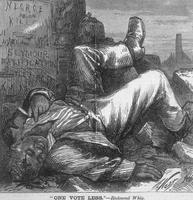1876
| Candidate |
Popular
|
Electoral
|
| Rutherford B. Hayes Republican |
4,034,311
|
185
|
| Samuel J. Tilden Democrat |
4,288,546
|
184
|
Rutherford B. Hayes by Mathew Brady (public domain) |
With the Panic of 1873 came the uncovering of various scandals in the Grant administration, and the issue of the 1876 election became reform. The Republicans nominated Rutherford B. Hayes, a man with an innocuous record, who campaigned on a vaguely reformist platform. Samuel J. Tilden, the Democratic candidate, was openly reformist.
Sectionalism still played a part in the country's politics as well. Thomas Nast and other cartoonists focused on the supposed "two-faced" campaigning that Tilden did on this issue (23A-1066991, 23B-1066992).
Intimidation, bribery, and violence were among the tactics used by both parties to gain votes in the South (23C-1066993, 23D-1066994). Because of disputed Southern votes, the election was given to an Electoral Commission in Congress, where a filibuster threatened to extend the counting process beyond March 4th, the day the new president was to take office. Dirty politics was suspected when Hayes was finally elected, and a civil war threatened, but Tilden bowed out, realizing the grave consequences of continued resistance, and Hayes stepped into the Presidency (23E-1066995).







